Seminole vs American Community Comparison
COMPARE
Seminole
American
Social Comparison
Social Comparison
Seminole
Americans
2,239
SOCIAL INDEX
19.9/ 100
SOCIAL RATING
265th/ 347
SOCIAL RANK
3,435
SOCIAL INDEX
31.9/ 100
SOCIAL RATING
220th/ 347
SOCIAL RANK
American Integration in Seminole Communities
The statistical analysis conducted on geographies consisting of 118,269,333 people shows a substantial positive correlation between the proportion of Americans within Seminole communities in the United States with a correlation coefficient (R) of 0.594. On average, for every 1% (one percent) increase in Seminole within a typical geography, there is an increase of 0.688% in Americans. To illustrate, in a geography comprising of 100,000 individuals, a rise of 1,000 Seminole corresponds to an increase of 687.7 Americans.
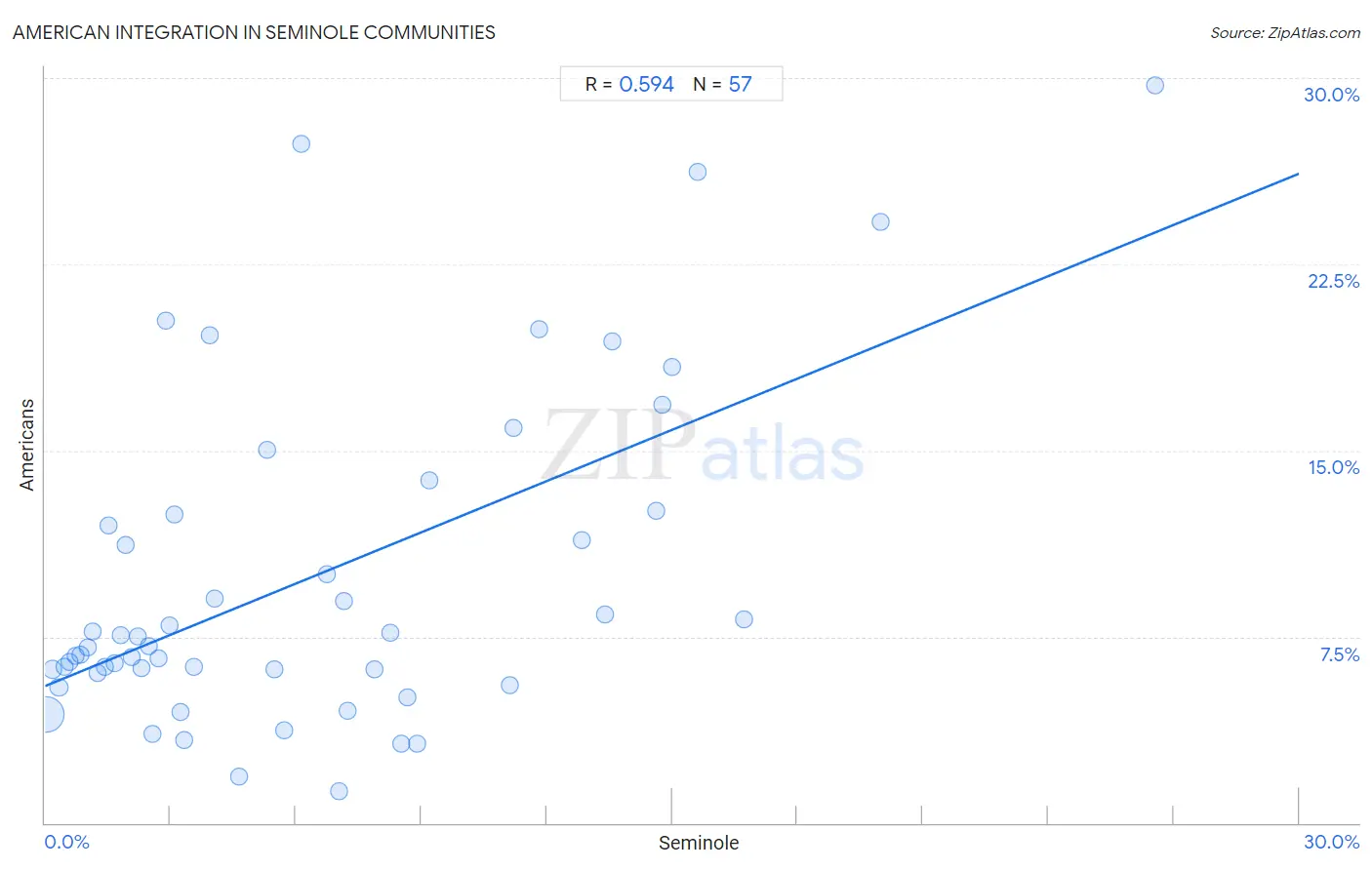
Seminole vs American Income
When considering income, the most significant differences between Seminole and American communities in the United States are seen in householder income ages 45 - 64 years ($80,077 compared to $90,536, a difference of 13.1%), householder income ages 25 - 44 years ($76,584 compared to $84,791, a difference of 10.7%), and median family income ($83,354 compared to $92,096, a difference of 10.5%). Conversely, both communities are more comparable in terms of median female earnings ($34,385 compared to $35,777, a difference of 4.1%), householder income over 65 years ($52,373 compared to $55,527, a difference of 6.0%), and median earnings ($40,233 compared to $42,742, a difference of 6.2%).

| Income Metric | Seminole | American |
| Per Capita Income | Tragic $36,180 | Tragic $39,039 |
| Median Family Income | Tragic $83,354 | Tragic $92,096 |
| Median Household Income | Tragic $69,420 | Tragic $75,932 |
| Median Earnings | Tragic $40,233 | Tragic $42,742 |
| Median Male Earnings | Tragic $46,783 | Tragic $50,761 |
| Median Female Earnings | Tragic $34,385 | Tragic $35,777 |
| Householder Age | Under 25 years | Tragic $45,649 | Tragic $48,860 |
| Householder Age | 25 - 44 years | Tragic $76,584 | Tragic $84,791 |
| Householder Age | 45 - 64 years | Tragic $80,077 | Tragic $90,536 |
| Householder Age | Over 65 years | Tragic $52,373 | Tragic $55,527 |
| Wage/Income Gap | Good 25.6% | Tragic 27.8% |
Seminole vs American Poverty
When considering poverty, the most significant differences between Seminole and American communities in the United States are seen in receiving food stamps (14.8% compared to 12.2%, a difference of 21.9%), family poverty (11.9% compared to 9.8%, a difference of 21.4%), and married-couple family poverty (6.4% compared to 5.3%, a difference of 20.8%). Conversely, both communities are more comparable in terms of single male poverty (16.0% compared to 15.8%, a difference of 1.4%), female poverty among 18-24 year olds (22.9% compared to 21.6%, a difference of 6.1%), and single mother poverty (35.8% compared to 33.5%, a difference of 6.9%).
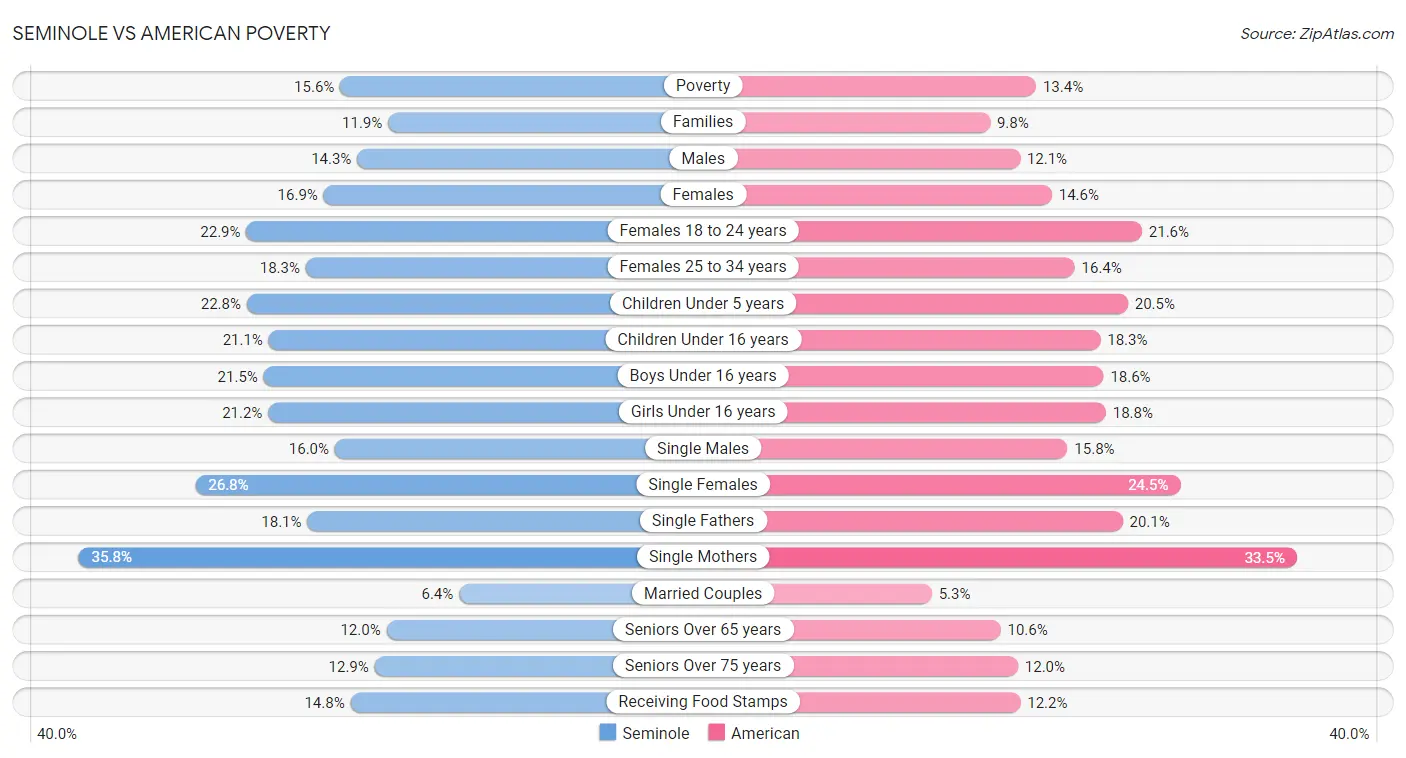
| Poverty Metric | Seminole | American |
| Poverty | Tragic 15.6% | Tragic 13.4% |
| Families | Tragic 11.9% | Tragic 9.8% |
| Males | Tragic 14.3% | Tragic 12.1% |
| Females | Tragic 16.9% | Tragic 14.6% |
| Females 18 to 24 years | Tragic 22.9% | Tragic 21.6% |
| Females 25 to 34 years | Tragic 18.3% | Tragic 16.4% |
| Children Under 5 years | Tragic 22.8% | Tragic 20.5% |
| Children Under 16 years | Tragic 21.1% | Tragic 18.3% |
| Boys Under 16 years | Tragic 21.5% | Tragic 18.6% |
| Girls Under 16 years | Tragic 21.2% | Tragic 18.8% |
| Single Males | Tragic 16.0% | Tragic 15.8% |
| Single Females | Tragic 26.8% | Tragic 24.5% |
| Single Fathers | Tragic 18.1% | Tragic 20.1% |
| Single Mothers | Tragic 35.8% | Tragic 33.5% |
| Married Couples | Tragic 6.4% | Fair 5.3% |
| Seniors Over 65 years | Tragic 12.0% | Good 10.6% |
| Seniors Over 75 years | Tragic 12.9% | Good 12.0% |
| Receiving Food Stamps | Tragic 14.8% | Fair 12.2% |
Seminole vs American Unemployment
When considering unemployment, the most significant differences between Seminole and American communities in the United States are seen in unemployment among seniors over 75 years (7.1% compared to 10.4%, a difference of 45.8%), unemployment (5.4% compared to 5.0%, a difference of 8.2%), and unemployment among ages 45 to 54 years (4.8% compared to 4.4%, a difference of 8.0%). Conversely, both communities are more comparable in terms of unemployment among ages 30 to 34 years (6.2% compared to 6.2%, a difference of 0.090%), unemployment among youth under 25 years (11.7% compared to 11.7%, a difference of 0.31%), and unemployment among ages 65 to 74 years (5.4% compared to 5.5%, a difference of 0.62%).
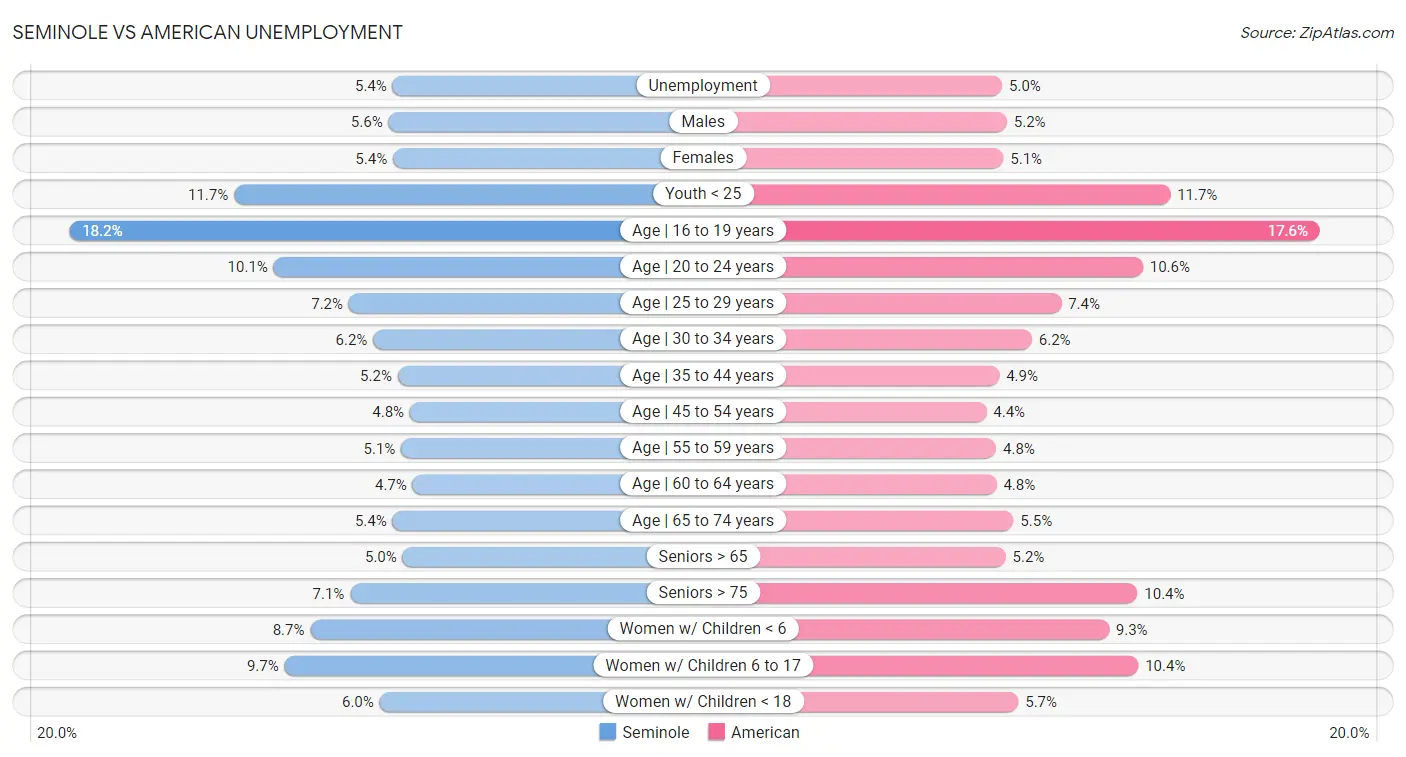
| Unemployment Metric | Seminole | American |
| Unemployment | Tragic 5.4% | Exceptional 5.0% |
| Males | Tragic 5.6% | Good 5.2% |
| Females | Poor 5.4% | Exceptional 5.1% |
| Youth < 25 | Fair 11.7% | Fair 11.7% |
| Age | 16 to 19 years | Tragic 18.2% | Average 17.6% |
| Age | 20 to 24 years | Excellent 10.1% | Tragic 10.6% |
| Age | 25 to 29 years | Tragic 7.2% | Tragic 7.4% |
| Age | 30 to 34 years | Tragic 6.2% | Tragic 6.2% |
| Age | 35 to 44 years | Tragic 5.2% | Tragic 4.9% |
| Age | 45 to 54 years | Tragic 4.8% | Excellent 4.4% |
| Age | 55 to 59 years | Tragic 5.1% | Good 4.8% |
| Age | 60 to 64 years | Exceptional 4.7% | Good 4.8% |
| Age | 65 to 74 years | Poor 5.4% | Tragic 5.5% |
| Seniors > 65 | Exceptional 5.0% | Fair 5.2% |
| Seniors > 75 | Exceptional 7.1% | Tragic 10.4% |
| Women w/ Children < 6 | Tragic 8.7% | Tragic 9.3% |
| Women w/ Children 6 to 17 | Tragic 9.7% | Tragic 10.4% |
| Women w/ Children < 18 | Tragic 6.0% | Tragic 5.7% |
Seminole vs American Labor Participation
When considering labor participation, the most significant differences between Seminole and American communities in the United States are seen in in labor force | age 16-19 (38.1% compared to 40.3%, a difference of 5.7%), in labor force | age 45-54 (78.1% compared to 80.4%, a difference of 2.9%), and in labor force | age 35-44 (80.4% compared to 82.4%, a difference of 2.5%). Conversely, both communities are more comparable in terms of in labor force | age > 16 (62.0% compared to 62.1%, a difference of 0.18%), in labor force | age 25-29 (81.7% compared to 83.1%, a difference of 1.7%), and in labor force | age 20-64 (75.5% compared to 77.0%, a difference of 2.0%).

| Labor Participation Metric | Seminole | American |
| In Labor Force | Age > 16 | Tragic 62.0% | Tragic 62.1% |
| In Labor Force | Age 20-64 | Tragic 75.5% | Tragic 77.0% |
| In Labor Force | Age 16-19 | Exceptional 38.1% | Exceptional 40.3% |
| In Labor Force | Age 20-24 | Tragic 74.3% | Exceptional 76.1% |
| In Labor Force | Age 25-29 | Tragic 81.7% | Tragic 83.1% |
| In Labor Force | Age 30-34 | Tragic 80.8% | Tragic 82.7% |
| In Labor Force | Age 35-44 | Tragic 80.4% | Tragic 82.4% |
| In Labor Force | Age 45-54 | Tragic 78.1% | Tragic 80.4% |
Seminole vs American Family Structure
When considering family structure, the most significant differences between Seminole and American communities in the United States are seen in single mother households (7.4% compared to 6.6%, a difference of 12.7%), married-couple households (44.0% compared to 47.9%, a difference of 9.0%), and divorced or separated (14.3% compared to 13.2%, a difference of 7.7%). Conversely, both communities are more comparable in terms of family households with children (27.5% compared to 27.3%, a difference of 0.83%), family households (64.0% compared to 65.5%, a difference of 2.4%), and average family size (3.24 compared to 3.16, a difference of 2.5%).

| Family Structure Metric | Seminole | American |
| Family Households | Poor 64.0% | Exceptional 65.5% |
| Family Households with Children | Average 27.5% | Fair 27.3% |
| Married-couple Households | Tragic 44.0% | Exceptional 47.9% |
| Average Family Size | Good 3.24 | Tragic 3.16 |
| Single Father Households | Tragic 2.6% | Tragic 2.4% |
| Single Mother Households | Tragic 7.4% | Poor 6.6% |
| Currently Married | Tragic 44.6% | Exceptional 48.0% |
| Divorced or Separated | Tragic 14.3% | Tragic 13.2% |
| Births to Unmarried Women | Tragic 37.9% | Tragic 36.4% |
Seminole vs American Vehicle Availability
When considering vehicle availability, the most significant differences between Seminole and American communities in the United States are seen in no vehicles in household (9.0% compared to 7.7%, a difference of 17.3%), 3 or more vehicles in household (20.9% compared to 22.6%, a difference of 8.2%), and 4 or more vehicles in household (7.0% compared to 7.5%, a difference of 7.1%). Conversely, both communities are more comparable in terms of 1 or more vehicles in household (91.1% compared to 92.5%, a difference of 1.5%), 2 or more vehicles in household (56.2% compared to 60.0%, a difference of 6.9%), and 4 or more vehicles in household (7.0% compared to 7.5%, a difference of 7.1%).

| Vehicle Availability Metric | Seminole | American |
| No Vehicles Available | Exceptional 9.0% | Exceptional 7.7% |
| 1+ Vehicles Available | Exceptional 91.1% | Exceptional 92.5% |
| 2+ Vehicles Available | Excellent 56.2% | Exceptional 60.0% |
| 3+ Vehicles Available | Exceptional 20.9% | Exceptional 22.6% |
| 4+ Vehicles Available | Exceptional 7.0% | Exceptional 7.5% |
Seminole vs American Education Level
When considering education level, the most significant differences between Seminole and American communities in the United States are seen in no schooling completed (1.9% compared to 1.7%, a difference of 16.2%), doctorate degree (1.3% compared to 1.5%, a difference of 15.0%), and professional degree (3.2% compared to 3.6%, a difference of 11.7%). Conversely, both communities are more comparable in terms of kindergarten (98.1% compared to 98.4%, a difference of 0.28%), 1st grade (98.1% compared to 98.4%, a difference of 0.28%), and nursery school (98.2% compared to 98.4%, a difference of 0.29%).
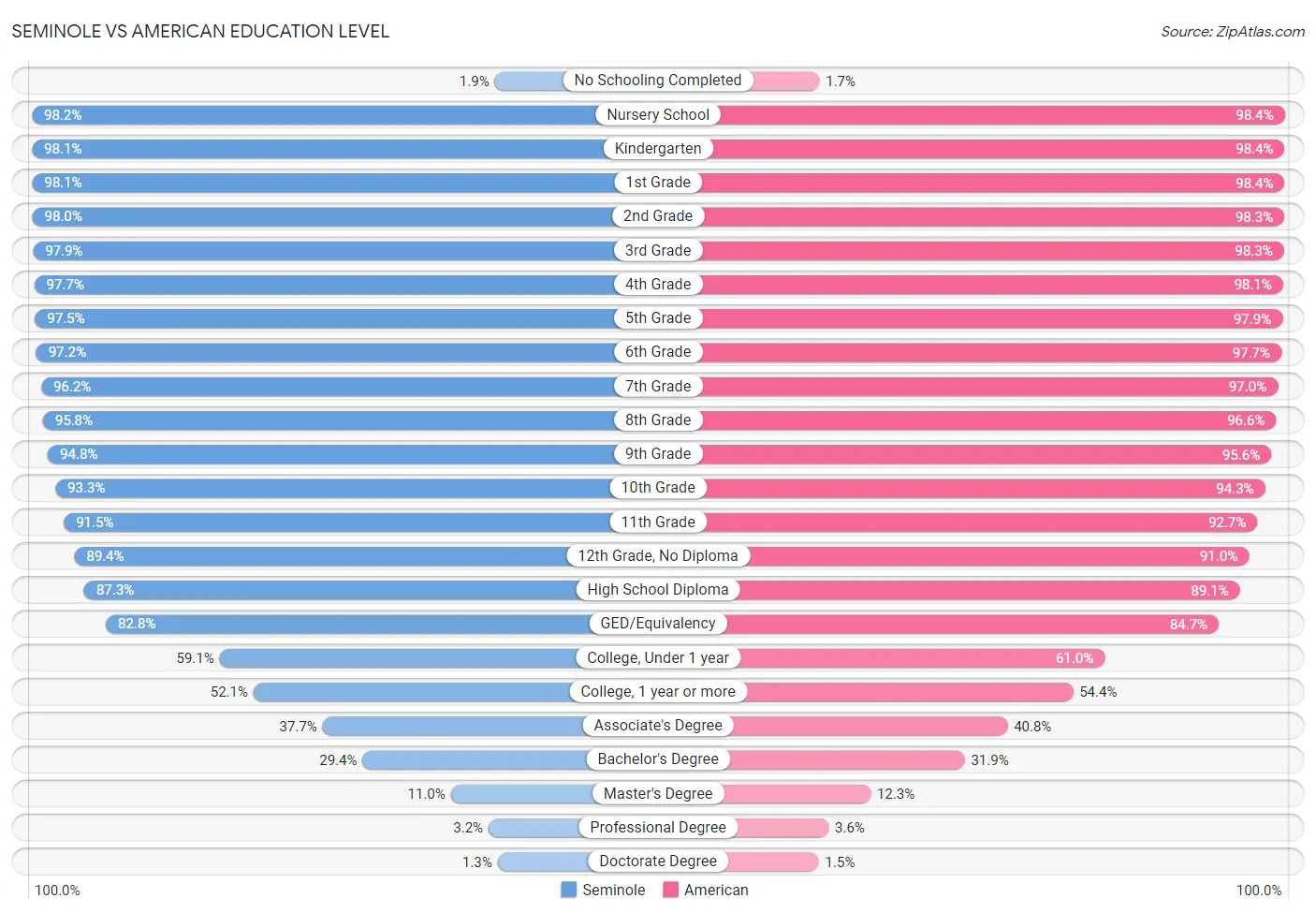
| Education Level Metric | Seminole | American |
| No Schooling Completed | Exceptional 1.9% | Exceptional 1.7% |
| Nursery School | Exceptional 98.2% | Exceptional 98.4% |
| Kindergarten | Exceptional 98.1% | Exceptional 98.4% |
| 1st Grade | Exceptional 98.1% | Exceptional 98.4% |
| 2nd Grade | Exceptional 98.0% | Exceptional 98.3% |
| 3rd Grade | Excellent 97.9% | Exceptional 98.3% |
| 4th Grade | Excellent 97.7% | Exceptional 98.1% |
| 5th Grade | Excellent 97.5% | Exceptional 97.9% |
| 6th Grade | Excellent 97.2% | Exceptional 97.7% |
| 7th Grade | Good 96.2% | Exceptional 97.0% |
| 8th Grade | Good 95.8% | Exceptional 96.6% |
| 9th Grade | Average 94.8% | Exceptional 95.6% |
| 10th Grade | Poor 93.3% | Exceptional 94.3% |
| 11th Grade | Tragic 91.5% | Good 92.7% |
| 12th Grade, No Diploma | Tragic 89.4% | Fair 91.0% |
| High School Diploma | Tragic 87.3% | Average 89.1% |
| GED/Equivalency | Tragic 82.8% | Tragic 84.7% |
| College, Under 1 year | Tragic 59.1% | Tragic 61.0% |
| College, 1 year or more | Tragic 52.1% | Tragic 54.4% |
| Associate's Degree | Tragic 37.7% | Tragic 40.8% |
| Bachelor's Degree | Tragic 29.4% | Tragic 31.9% |
| Master's Degree | Tragic 11.0% | Tragic 12.3% |
| Professional Degree | Tragic 3.2% | Tragic 3.6% |
| Doctorate Degree | Tragic 1.3% | Tragic 1.5% |
Seminole vs American Disability
When considering disability, the most significant differences between Seminole and American communities in the United States are seen in vision disability (3.1% compared to 2.6%, a difference of 15.5%), disability age 65 to 74 (29.4% compared to 25.8%, a difference of 14.0%), and disability age 35 to 64 (15.9% compared to 13.9%, a difference of 14.0%). Conversely, both communities are more comparable in terms of disability age 5 to 17 (6.8% compared to 6.5%, a difference of 3.5%), self-care disability (2.9% compared to 2.8%, a difference of 4.1%), and hearing disability (4.1% compared to 3.9%, a difference of 4.9%).
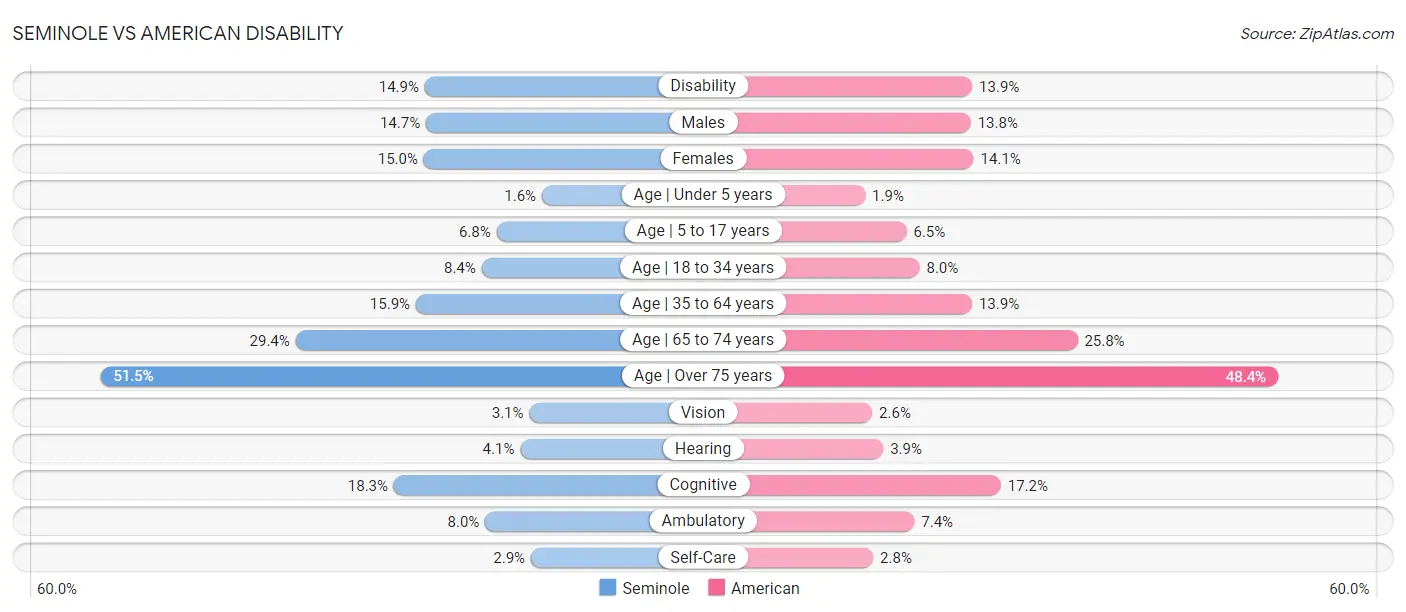
| Disability Metric | Seminole | American |
| Disability | Tragic 14.9% | Tragic 13.9% |
| Males | Tragic 14.7% | Tragic 13.8% |
| Females | Tragic 15.0% | Tragic 14.1% |
| Age | Under 5 years | Tragic 1.6% | Tragic 1.9% |
| Age | 5 to 17 years | Tragic 6.8% | Tragic 6.5% |
| Age | 18 to 34 years | Tragic 8.4% | Tragic 8.0% |
| Age | 35 to 64 years | Tragic 15.9% | Tragic 13.9% |
| Age | 65 to 74 years | Tragic 29.4% | Tragic 25.8% |
| Age | Over 75 years | Tragic 51.5% | Tragic 48.4% |
| Vision | Tragic 3.1% | Tragic 2.6% |
| Hearing | Tragic 4.1% | Tragic 3.9% |
| Cognitive | Tragic 18.3% | Good 17.2% |
| Ambulatory | Tragic 8.0% | Tragic 7.4% |
| Self-Care | Tragic 2.9% | Tragic 2.8% |